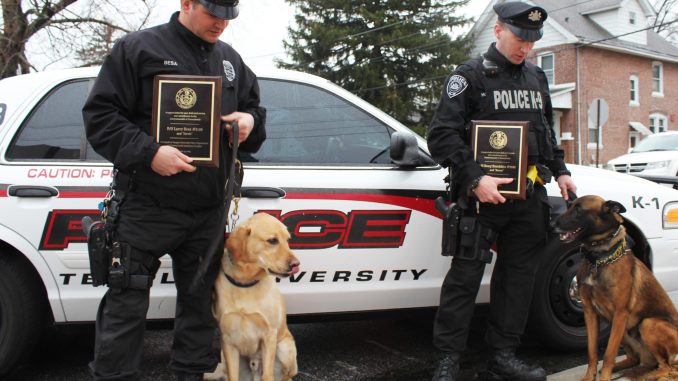
The air smelled faintly of wet dog.
The Stoney Creek Veterinary Hospital, located at 701 Kedron Ave. in Morton, held its fourth annual K9 Veterans’ Day Celebration on Saturday, March 14. Rain showers didn’t stop 200-250 people from gathering in tents outside the hospital to thank four-legged service workers.
Two members of Temple’s K9 unit, Officer Doug Hotchkiss and Officer Larry Besa, along with their dogs – Baron and Jarvis – received recognition at the event.
Both dogs assisted in the 48-day search for fugitive Eric Frein, who was wanted after he shot and killed Cpl. Bryon Dickson and injured Trooper Alex Douglass in September 2014. Frein, who was caught in Pocono Township on Oct. 30, faces 12 charges, including terrorism, murder in the first degree, homicide of a law enforcement officer and possession of weapons of mass destruction.
Dogs like Baron and Jarvis, who are trained in tracking, were able to detect and follow Frein’s scent while he traversed through mountainous terrain.
“They’re really talented dogs,” said Kathy McCarry, a dog therapist and the event planner. “They’re really talented, and they don’t ask for anything in return. Just a pat on the head.”
At 1 p.m., police, veteran and therapy dogs were honored during an hour-long award ceremony, during which several state representatives spoke and awarded plaques and certificates to dog handlers.
Among others awarded were Officer Jennifer Doyle, Abington Township Police Department’s first female canine police officer, and her K9 partner Bella.
After the presentations, the crowd moved to the veterinary hospital’s memorial garden to honor fallen service canines. From 2-4 p.m., dogs were pampered inside the Stoney Creek Veterinary Hospital.
“This whole day is about the dogs,” McCarry said.
Canines got their nails trimmed, their ears cleaned and even received 10-minute massages and laser therapy, a process involving infrared light lasers that relieve sore muscles by penetrating tissue cells, McCarry said.
“We celebrate [dogs], we recognize them, and we give them a day in return,” said Dr. Jennifer Johnson, the owner of Stoney Creek Veterinary Hospital.
The event was a first for Hotchkiss, who has owned Baron – a Belgian shepard retriever – for three years.
“Baron is an awesome dog,” Hotchkiss said. “If I need to be protected, he’ll be there to protect me. As soon as I bring him out, nobody wants to play.”
The companionship between service dogs and their handlers extends beyond their duties – at the end of every workday, Hotchkiss and Besa take their dogs home.
“[Baron] is a cuddlebug at home,” said Kerry Hotchkiss, Doug’s wife. “You wouldn’t even know what he does.”
McCarry said police canines cost on average between $10,000 and $12,000. Baron, who is three years old, came from Holland.
Besa said he chose to work with 5-year-old Jarvis, a Labrador retriever, because he’s a “hard worker, has a lot of drive, and he’s excited. He constantly wants to work.”
Jarvis makes frequent trips around Main Campus with Besa. “Students love him,” Besa said. “He’s really well behaved. When it’s time to go to work, he turns it on. But when it’s not, he’s a good dog.”
Johnson said funding for the event came from Megan’s Fund, the hospital’s fund for pets and clients that require medical service they can’t afford. Handlers must pay out of pocket for dogs that can no longer provide service, Johnson said.
Besa said he believes every police department should have canines. “They make the jobs of officers so much easier – whether on the tracking end of it, the protection end of it, finding explosives, finding narcotics – whatever their speciality is,” Besa said. “Their noses don’t lie.”
Special treatments for dogs and service demonstrations, held by organizations like the U.S. Customs and Border Protection agency, ran throughout the day. McCarry and Johnson said Stoney Creek Veterinary Hospital will continue to hold the celebration annually.
“It’s been a great experience,” Johnson said. “A lot of people don’t realize how many dogs are used for such important services in our community, and we get to recognize the dogs and the great work that they do. Many of us owe our lives to dogs.”
Claire Sasko can be reached at claire.sasko@temple.edu.


Be the first to comment